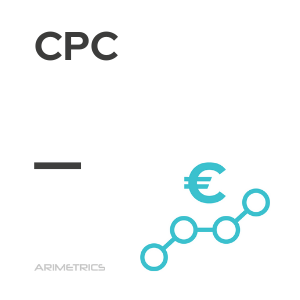
Definition:
Cost per click (CPC) is an internet advertising model used to drive traffic to websites where advertisers pay the publisher, usually a platform or search engine, when the ad is clicked. It is defined as the amount spent that is made when an ad is clicked.
The CPC in search engines
In search engines, they display the results corresponding to the target search keyword, appearing above or below the organic results on the search engine results pages, or on the sites defined by each platform. This type of advertising is called sponsored links or sponsored ads.
Once the click occurs, the user is taken to a landing page, or a call is made to the advertiser’s phone in the case of mobile call ads.
The Cost per click is also used in social media campaigns (Facebook, Instagram, Twitter, LinkedIn, etc.) maintaining the same meaning. In Marketplaces such as Amazon, clicks are directed to internal pages of the marketplace itself.
CPC Formula
The formula of the CPC is as follows:
CPC = Total cost / number of clicks
Where it is used in CPC
Among the advertising platforms that use the Cost per Click we can highlight:
- Google Ads
- Bing Ads
- Facebook Ads
- LinkedIn Ads
- Twitter Ads
- Youtube
While all of them offer ads where the advertiser stops per click, the subsequent interaction can be the view to a web page, a like, a form …
Types of CPCs
Several types of CPCs can be distinguished:
- Fixed CPC: The advertiser pays the agreed cost per click regardless of any other factor
- CPC Auction: There is a ad auction in which the highest bidder (taking into account some other variables) is the one who manages to advertise (in case there is a single position) or achieves the first position (as in the paid ads of Google and Bing search engines)
The CPC in search engines
Across different search engines, advertisers typically bid on keywords relevant to their target market. Content sites often charge a fixed price for each click instead of using an auction system. Banners are also CPC ads.
Instead of looking for a high volume of traffic to a site, the CPC tries to attract quality customers, so it implements the so-called affiliate model, which offers buying opportunities where people are browsing. Through financial incentives (in the form of a percentage of revenue) to affiliate partner sites, a pay-for-performance model is created: if an affiliate does not generate sales, it does not represent any cost to the merchant. Variations to this system include banner sharing, pay-per-click, and revenue-sharing programs.
The CPC in Google Ads
In Google Ads there are several bidding models based on the CPC:
- Manual CPC Bidding: This type of bid defines the maximum cost per click that you are willing to pay.
- Enhanced CPC Bidding:The platform is allowed to bid above the set CPC if it considers that there are more options to convert for a given query.
Advantages of CPC
If we compare it with other models, such as the cost per impression, the CPC has the great advantage that it informs about the effectiveness of advertising,by directly relating the investment with the results. The number of clicks is a way to measure the attention and interest that the ad produces.
It is an efficient bidding system, since it is only paid when someone clicks, and this happens in most cases because that user has an interest in what is advertised there.
Disadvantages of CPC
The CPC advertising model lends itself to abuses such as fraudulent clicks by both competitors in the case of search ads and advertisers in Display advertising, although both Google and other platforms have implemented automated systems to prevent abusive clicks by competitors or corrupt web developers.
Tips for optimizing CPC
Among the recommendations to improve the CPC we can highlight:
- Analyze the most relevant keywords in the sector. For this you can use tools such as the keyword tool of Google, Sistrix or Semrush.
- Segment traffic geographically and demographically based on the CTR obtained. It is important for this to have a good measurement of Web Analytics, as well as to perform periodic analysis to analyze the evolution of cost, engagement and conversion for each keyword.
- Do A/B Testing with the design and creatives of the ads. For this you can use tools such as Google Optimize.
- Look for relevance between what is advertised and the product/service that the user will see at the end. In Google Ads, the relevance of the ads (that the ad corresponds to what is offered on the landing page), is a fundamental factor in calculating the level of quality of a keyword.
- Analyze conversionsto verify that the paid CPC is profitable. To do this, it is necessary to define the conversions in the CPC platform and in the web analytics tool.
